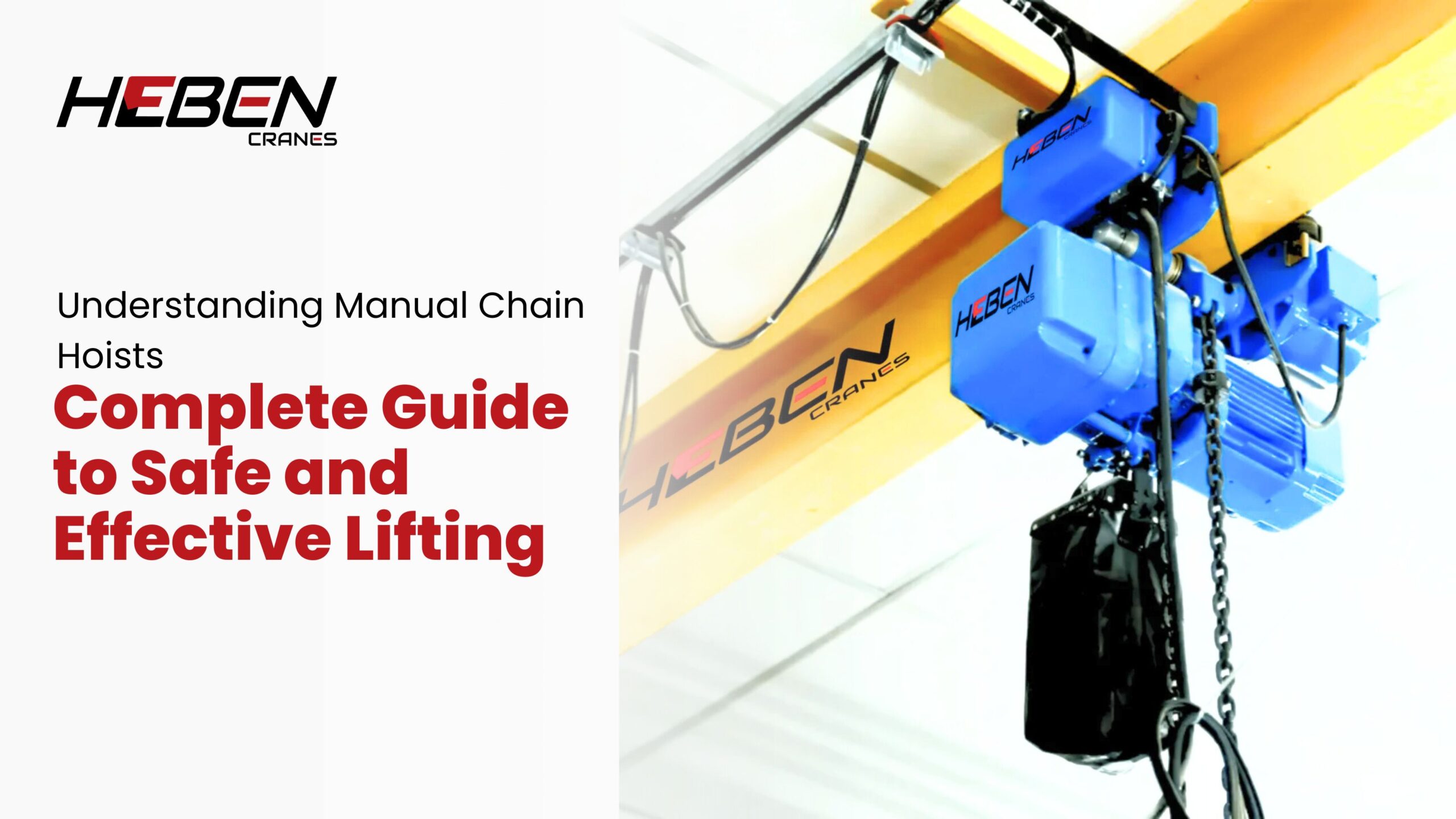Walk into any busy warehouse, construction site, or fabrication shop, and you’ll likely spot a manual chain hoist quietly shouldering the heavy lifting. These compact, robust devices are the unsung heroes of material handling, empowering teams to move tons of steel, machinery, or goods with little more than the pull of a chain. In India’s rapidly industrializing landscape, manual chain hoists are not just tools—they’re the backbone of safe, efficient, and cost-effective operations.
What makes them so indispensable? It’s their blend of simplicity, reliability, and versatility. From the bustling docks of Mumbai to remote wind farms where electricity is a luxury, manual chain hoists enable productivity where it matters most. As one industry leader put it, “A manual chain hoist is the difference between a day’s work and an impossible task.”
The Fundamentals: What Is a Manual Chain Hoist and How Does It Work?
A manual chain hoist—sometimes called a chain block or chain pulley block—is a mechanical device designed to lift, lower, and precisely position heavy loads by hand. Unlike electric or pneumatic hoists, it requires no external power source, making it ideal for environments where reliability and portability are paramount.
The operation is elegantly simple: a hand chain is pulled, turning a wheel that engages a series of gears and friction plates. This multiplies the user’s force, allowing a single person to lift weights that would otherwise require a team. The load chain, made of high-strength alloy steel, passes over a sprocket, raising or lowering the load attached to a robust safety hook. A built-in brake system ensures the load stays securely in place when not being moved.
Manual chain hoists come in a range of capacities, typically from 0.5 to 20 tonnes, and can be mounted to a fixed point or attached to a trolley for horizontal movement. Their design prioritizes safety, with features like double pawl systems, asbestos-free friction discs, and hooks that bend gradually under overload rather than snapping—a crucial safeguard in high-risk environments.
Anatomy of a Manual Chain Hoist: Key Components and Their Functions
Dissecting the Chain Hoist
- Load Chain: Forged from Grade 8 or higher alloy steel, the load chain is the workhorse—resistant to wear, corrosion, and deformation.
- Hand Chain: Operated by the user, this looped chain drives the internal gears. Stainless steel variants are available for food or cleanroom applications.
- Gear Mechanism: Precision-engineered gears multiply input force, making it possible to lift several tonnes with minimal effort.
- Brake System: Typically a single-action friction brake, it automatically engages to hold the load securely when the hand chain is released.
- Hooks: Both top and bottom hooks feature safety latches and are designed to deform under excessive load, providing a visual warning before failure.
- Housing: Steel or powder-coated housings protect internal components from dust, moisture, and impact.
Why These Details Matter?
A robust brake system and high-grade chains are not just technical details—they’re the difference between a safe lift and a catastrophic failure. As one manufacturer notes, “In case of overload, the hooks will gradually bend and do not abruptly break off.” This design philosophy is echoed in global safety standards like EN13157 and ASME B30.21C, ensuring that even in the toughest conditions, safety is never compromised.
Selecting the Right Manual Chain Hoist for Your Application
Choosing the right hoist isn’t just about picking a weight rating off the shelf. It’s a nuanced decision that weighs factors like:
- Load Capacity: Always select a hoist with a rated capacity exceeding your heaviest expected load. Most chain pulley blocks have a safety factor of 4:1, meaning they can handle loads four times their rated capacity in controlled conditions—a testament to their engineering margin.
- Lift Height: Standard lifts are typically 3 meters, but custom lengths are available. Measure the vertical distance required and add a margin for safe operation.
- Operating Environment: For corrosive, food-grade, or cleanroom environments, opt for stainless steel or nickel-plated chains and components.
- Mounting Options: Will the hoist be stationary, or does your workflow require a trolley-mounted system for horizontal movement? Compatibility with monorail cranes, jib cranes, or underslung EOT cranes (see “Advantages of Modern Underslung EOT Cranes”) can dramatically boost productivity.
- Frequency of Use: For intensive, daily operations, invest in models with ergonomic features and enhanced safety systems.
Safe Lifting Principles: Core Safety Standards and Best Practices
Skimmable Safety Essentials
- Never exceed the hoist’s rated capacity. Overloading is the leading cause of hoist failure and workplace accidents.
- Inspect before every use. Look for chain wear, hook deformation, and brake responsiveness.
- Lift vertically. Angled lifts introduce dangerous side loads that can cause catastrophic failure.
- Keep hands and body clear of the load path. Even the best hoist can’t defy gravity if something goes wrong.
- Follow manufacturer’s instructions. Each model has unique features—know them inside out.
Recent studies show that up to 60% of lifting-related accidents in Indian industries are due to improper hoist use or neglected inspections. “The manual hoist must be properly operated and maintained at all times,” stresses one leading manufacturer’s manual.
Pre-Use Inspection: Ensuring Readiness and Reliability
Skimmable Inspection Checklist
- Visual Check: Examine the load and hand chains for cracks, elongation, or corrosion.
- Hook Inspection: Ensure safety latches are functional and hooks are free from distortion.
- Brake Test: Lift a light load and check that the brake engages instantly when the hand chain is released.
- Gear and Housing: Listen for unusual noises during operation—grinding or clicking could indicate internal wear.
- Labels and Markings: Confirm that capacity labels are legible and match your application.
A zinger to remember: “A five-minute inspection can prevent a five-ton disaster.”
Step-by-Step Operation: From Setup to Safe Lifting
Operating a manual chain hoist is straightforward, but precision matters:
- Secure Mounting: Attach the hoist to a certified anchor point or trolley. Double-check all connections.
- Attach Load: Hook the load securely, ensuring the center of gravity is directly beneath the hoist.
- Lift Smoothly: Pull the hand chain in a steady, controlled motion. The gears and friction plates will do the heavy lifting, but avoid jerky movements.
- Pause and Hold: The brake system will engage automatically when you stop pulling, holding the load safely in place.
- Lower with Care: To lower, pull the hand chain in the opposite direction, maintaining control throughout.
As one technical guide explains, “Pulling the hand chain clockwise presses the friction plates and the ratchet disc tightly against the brake seat, turning the drive shaft… smoothly moving the load chain and hook upward.”
Advanced Safety Protocols: Preventing Hazards and Responding to Emergencies
In high-stakes environments—think offshore rigs or seismic zones (see “Are Your Structures Safe? Understanding Seismic Loads in Earthquake Zones”)—advanced safety protocols are non-negotiable.
- Double Pawl Systems: These provide redundancy in the brake mechanism, ensuring the load stays put even if one pawl fails.
- Overload Protection: Some premium hoists feature slip clutches or load limiters that prevent operation if the load exceeds safe limits.
- Emergency Procedures: Train staff to respond swiftly to brake failure, chain slippage, or unexpected load shifts. “Always lift/lower the load vertically,” cautions one manual, underscoring the importance of technique even in emergencies.
Maintenance Mastery: Extending the Life and Performance of Your Hoist
Routine maintenance isn’t just about longevity—it’s about safety and efficiency.
- Lubrication: Regularly lubricate the load chain and gears to reduce wear and prevent corrosion.
- Brake Adjustment: Periodically test and adjust the brake to maintain optimal holding force.
- Component Replacement: Replace worn chains, hooks, or friction discs promptly. Never attempt makeshift repairs.
- Record Keeping: Maintain detailed logs of inspections, maintenance, and repairs—a practice mandated by many safety standards.
A well-maintained hoist can deliver decades of reliable service. As one expert notes, “The chain block can be attached to a trolley of any type as traveling chain block. It is suitable to monorail overhead conveying system, hand traveling crane and jib crane,” highlighting the adaptability and long-term value of these devices.
Common Mistakes and How to Avoid Them
- Ignoring Load Limits: Even with a 4:1 safety factor, never push your luck. The consequences of overload are severe and often irreversible.
- Skipping Inspections: Small defects can escalate rapidly under load.
- Improper Rigging: Side loading or uneven weight distribution can cause hooks to deform or chains to snap.
- Neglecting Training: Ensure all operators are trained not just in operation, but in emergency response and maintenance.
For a deeper dive into load ratings and efficiency, see “Understanding SWL in EOT Cranes: Ensure Safe Lifting & Maximize Efficiency.”
Innovations and Trends: The Future of Manual Chain Hoists
The manual chain hoist is hardly a relic—recent innovations are redefining what’s possible.
- Materials Science: Advanced alloys and coatings are boosting strength-to-weight ratios and corrosion resistance.
- Ergonomics: New designs reduce operator fatigue with smoother hand chain action and lighter housings.
- Smart Integration: Some manufacturers are experimenting with load sensors and digital monitoring, bringing manual hoists into the era of Industry 4.0.
Global demand for manual chain hoists is projected to grow steadily, driven by infrastructure expansion in emerging economies and a renewed focus on workplace safety.
Why Partner with Heben Technovation Pvt. Ltd. for Your Lifting Solutions?
When it comes to safe, effective lifting, expertise matters. Heben Technovation Pvt. Ltd. combines deep technical know-how with a commitment to innovation and customer support. Whether you need a standard hoist or a custom-engineered solution, their team ensures every product meets the highest standards of safety, reliability, and performance.
Conclusion: Empowering Safe, Efficient, and Effective Lifting
Manual chain hoists are more than just tools—they’re enablers of progress, safety, and efficiency. By understanding their mechanics, respecting their limits, and embracing best practices, you can transform your lifting operations and build a foundation for long-term success. In a world where every lift counts, knowledge is your ultimate lever.




